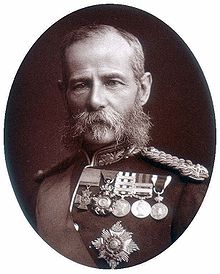|
Kandahar (ski course)
Kandahar is a classic World Cup downhill ski course in Bavaria, Germany, opened in 1936. It is located at the Garmisch Classic ski area on the Zugspitze above Garmisch-Partenkirchen.[1] Since 1954, the competition called Arlberg-Kandahar races have been held here, which is rotating with other notable downhill ski courses in Austria, Switzerland, France, and Italy. In 2009, the new "Kandahar 2" course opened, parallel to the original, which became "Kandahar 1".[2][3] With a max. incline of 42.6 degrees (92%), it has the 2nd steepest gradient on the World Cup circuit. Kandahar 1The name originThe course was named after Sir Frederick Roberts, a British Victorian era major general who was known as "Baron of Kandahar", who led the Kabul Field Force in the Second Anglo-Afghan War and defeated Ayub Khan at the Battle of Kandahar. The Kandahar Ski Club of Mürren, Switzerland, was founded by Arnold Lunn and other British skiers in early 1924. Women's courseThe original Kandahar 1 course was built for the Olympic debut of alpine skiing in 1936 was used to for all men and women, since 2009 only used for women's speed events, as they built a new parallel, more demanding "Kandahar 2" downhill ski course for men only. It starts on "Tröglhang" at 1,490 m (4,888 ft) (AA), and follows mainly the old men's route. After the "Schußanger" with two curves, "Himmelreich" jump follows where the Super-G start is located, then "Bödele". Then comes the "Waldeck" with 85% gradient, the steepest section in women's circuit and a technically very demending traverse. From 2009, course from there continues by newly built route where also giant slalom starts; the "Eishang" is bypassed by via the "Ramwiesen" and via the "Höllentor" it returns to the original Kandahar in "Hölle", the steep section. Then passing the "FIS Schneise", a sloping run that, after a hard left-hand bend, ends in the men's course just before the "Tauber-Schuss".[4] K1 course sections
Kandahar 2Men's courseA new downhill run for men in 2009, "Kandahar 2" shares the same start and finish with the original course. It begins at the original start at 1,690 m (5,545 ft) (AA) on Kreuzjoch mountain, reaching speed up to 100 km/h (62 mph) after the "S-Kurve". After the "Tröglhang", the steepest section until 2008, the course continues into newly built route in 2009 to "Olympia-Kurve" and then to "Panorama-Sprung". After that comes the "Alte Quelle", before the route at the "Bödele" returns into the original Kandahar to the start of the giant slalom above "Eishang" and after the cable car jump (40 to 60 m (130 to 195 ft)), the racers turn right into the second newly designed part at the "Kramersprung" (20 to 40 m (65 to 130 ft)). Then to the next newly section called "Padöls" and into "Auf der Mauer" flat passage. Next is "Frei Fall", with 92% incline, the absolute steepest section in this competition. At the end, last couple of hundred metres, routes joins with the old original course into the "Tauber-Schuss" and a twenty-metre (65 ft) jump just before the finish line. K2 course sections
OlympicsMen's events
Women's events
Combined (both downhills held on "Kandahar" and both slaloms on "Gudiberg" course.) World ChampionshipsMen's eventsLocation in Germany Location in the Alps
Women's events
Team event
World CupThe World Cup circuit debuted in January 1967.
Men Cancelled SL in St. Anton (1992) was replaced in Ga-Pa and with scheduled DH there counted for classic combined. WomenNot in original calendar. It replaced Val d'Isere (2013). SectionsKandahar 1 (W)
Kandahar 2 (M)
Fatal accidentsOn 29 January 1994, Austrian ski racer Ulrike Maier suffered fatal injuries at "FIS Schneise" section crashing into intermediate timing device at 105 km/h (65 mph) during the World Cup downhill event. A week before, she won a giant slalom in Maribor.[5][6][7] Thirty-five years earlier in 1959, Canadian John Semmelink crashed into a rock-filled gully and later succumbed to his injuries.[8] Held on an icy course on 7 February in challenging conditions of fog and flat light, Semmerlink was the 44th racer on the course. At a lower section named Himmelreich (heaven) just 500 yards (460 m) from the finish, witnesses said one of his bindings opened and he crashed into a rock-filled gully.[9] Semmerlink had a serious head injury and was taken by U.S. Army helicopter to a nearby U.S. military dispensary, but died of his injuries.[9][10] Of the 89 starters, 39 did not finish the race.[9][11] Club5+In 1986, elite Club5 was originally founded by prestigious classic downhill organizers: Kitzbühel, Wengen, Garmisch, Val d’Isère and Val Gardena/Gröden, with goal to bring alpine ski sport on the highest levels possible.[12] Later over the years other classic longterm organizers joined the now named Club5+: Alta Badia, Cortina, Kranjska Gora, Maribor, Lake Louise, Schladming, Adelboden, Kvitfjell, St.Moritz and Åre.[13] References
External links
|
||||||||||||||||||||||||||||||||||||||||||||||||||||||||||||||||||||||||||||||||||||||||||||||||||||||||||||||||||||||||||||||||||||||||||||||||||||||||||||||||||||||









